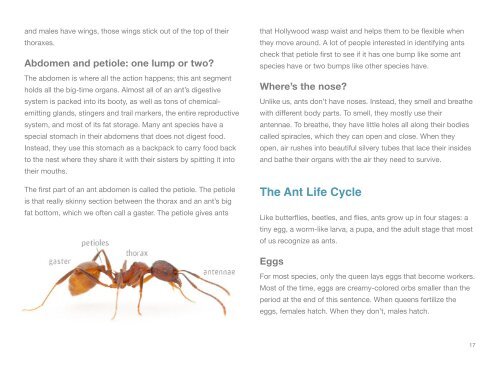th15IH
th15IH
th15IH
You also want an ePaper? Increase the reach of your titles
YUMPU automatically turns print PDFs into web optimized ePapers that Google loves.
and males have wings, those wings stick out of the top of their<br />
thoraxes.<br />
Abdomen and petiole: one lump or two?<br />
The abdomen is where all the action happens; this ant segment<br />
holds all the big-time organs. Almost all of an ant’s digestive<br />
system is packed into its booty, as well as tons of chemicalemitting<br />
glands, stingers and trail markers, the entire reproductive<br />
system, and most of its fat storage. Many ant species have a<br />
special stomach in their abdomens that does not digest food.<br />
Instead, they use this stomach as a backpack to carry food back<br />
to the nest where they share it with their sisters by spitting it into<br />
their mouths.<br />
The first part of an ant abdomen is called the petiole. The petiole<br />
is that really skinny section between the thorax and an ant’s big<br />
fat bottom, which we often call a gaster. The petiole gives ants<br />
that Hollywood wasp waist and helps them to be flexible when<br />
they move around. A lot of people interested in identifying ants<br />
check that petiole first to see if it has one bump like some ant<br />
species have or two bumps like other species have.<br />
Where’s the nose?<br />
Unlike us, ants don’t have noses. Instead, they smell and breathe<br />
with different body parts. To smell, they mostly use their<br />
antennae. To breathe, they have little holes all along their bodies<br />
called spiracles, which they can open and close. When they<br />
open, air rushes into beautiful silvery tubes that lace their insides<br />
and bathe their organs with the air they need to survive.<br />
The Ant Life Cycle<br />
Like butterflies, beetles, and flies, ants grow up in four stages: a<br />
tiny egg, a worm-like larva, a pupa, and the adult stage that most<br />
of us recognize as ants.<br />
Eggs<br />
For most species, only the queen lays eggs that become workers.<br />
Most of the time, eggs are creamy-colored orbs smaller than the<br />
period at the end of this sentence. When queens fertilize the<br />
eggs, females hatch. When they don’t, males hatch.<br />
17


